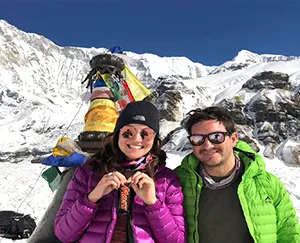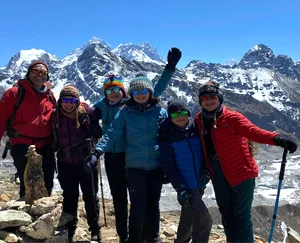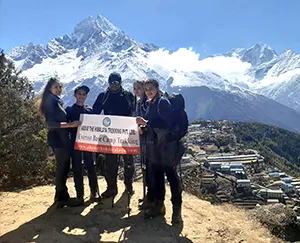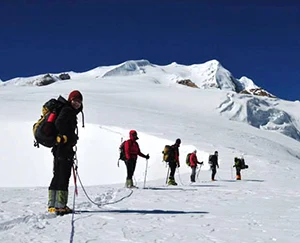Climbing Equipment List for Mera peak climbing base camp service
The following are all you need to pack before your Mera peak climbing base camp service journey:
Climbing Gear
- Ice axe
- Crampons
- Climbing harness
- Helmet
- Carabiners (locking and non-locking)
- Ascender and descender
- Safety rope and climbing rope
- Ice screw and snow bar
Clothing
- Down jacket
- Down pants
- Waterproof jacket and trousers
- Thermal base layers (top and bottom)
- Fleece jacket or sweater
- Trekking pants and shirts
- Warm gloves and mittens
- Woolen hat and neck warmer
- Gaiters and warm trekking socks
Footwear
- Mountaineering boots (double insulated recommended)
- Trekking shoes
- Slippers
Personal Essentials
- Sleeping bag (rated to -20 degrees Celsius or lower)
- Headlamp with extra batteries
- Sunglasses and snow goggles
- Sunscreen and lip balm
- Personal first aid kit and medicine
- Water bottles or a thermos
- Energy bars or snacks
- Toiletries and a small towel
Other Items
- Backpack (day pack)
- Duffel bag (provided by the company)
- Trekking poles
- Camera or phone for photos
- Power bank or spare batteries
Best Season To Go For Mera peak climbing base camp service
The two best seasons to go for Mera Peak climbing are autumn and spring. These seasons see good weather conditions throughout the day, clean trails, and easily available amenities. The following is a brief detail of all the seasons for Mera Peak climbing:
Spring
Spring is perfect for Mera peak climbing base camp service. The weather is clear and the air is fresh throughout the day. There is a lesser possibility of rainfall and excessive snowfall. Hence, the trails are easy to trek through.
During this season, you can also enjoy blooming rhododendrons, and the visibility is just as excellent. The daytime temperatures are comfortable, while the nighttime temperature is slightly chilly yet not so much as to make you uncomfortable, given you are decently clothed and have a sleeping bag with you.
The amenities are easily accessible, and you can always enjoy group trekking with people outside your trekking group, as spring is very common for trekking. And, photography opportunities are just as good.
Autumn
Autumn is another good season to go on the Mera peak climbing base camp service. You can take the best pictures of the surroundings during this season because of good visibility. Rainfall is less likely, which makes the trails easier to trek through.
The daytime temperatures are mild and not too cold, while the nights can get slightly chillier. If you wear clothes and have enough equipment to overpower the cold, the temperature won’t be that much of a problem.
You can easily find accessibility to amenities. Trekking in groups and finding people with similar interests is just as easy. Similarly, you don’t have to face too many delays or can successfully avoid any delays.
Summer/Monsoon
Summer and monsoon are the least preferred seasons for going to Mera peak climbing base camp service. The days are mostly rainy, and you always have to endure harsh weather conditions, even when you begin the three-day journey from Khare to Khare.
Carrying rain gear can be a bit of a hassle. Visibility can be an issue as well. You won’t easily find amenities during summer and especially monsoon as much as you do during peak seasons like spring and autumn.
Summer can also prove to be very hot when you’re trekking uphill and downhill on the rather challenging trails. You may face delays throughout the journey because of weather uncertainties. Trekkers who want to enjoy a peaceful time and travel on a budget can opt for this season for Mera peak climbing base camp service.
Winter
Winter is also popular as a trekking season for trekkers and mountaineers going for Mera peak climbing base camp service. Compared to beginner trekkers, it is always the more experienced ones who take on this journey as an adrenaline-triggering one.
Snowfall is higher in winter than in any other season. Also, you may not find it as simple to find amenities as you do during the peak seasons including autumn and spring. The day temperature can be very low, while the night temperature can be even chillier, making it tough for one to stay overnight at the High Camp.
You may face delays during the journey. If you want to experience a peaceful and very adventurous trek and travel with a lower budget, Mera Peak climbing in winter could be ideal for you. Be sure to get in touch with someone with similar experiences before, and do your research well before you decide to go for Mera Peak climbing.
Accommodation and Food Details During Mera peak climbing base camp service
Accommodation and food during Mera Peak climbing are decent and comfortable for trekkers. You will get good rooms with proper bedding and blankets, along with clean pillows. Similarly, you can also enjoy fulfilling meals three times a day.
The following are details of the accommodation and food you can expect during Mera peak climbing base camp service:
Lodges in Khare
Khare is located at an altitude of 4,950m. Trekkers will stay in basic accommodation. The lodges here have nothing extravagant. Still, you will get twin beds in a room that also allows sufficient ventilation.
It is optional for you to carry a pillow and a small blanket of your own, as you will get both a clean pillow and blankets at the lodge. The bathrooms in local lodges are made for all the trekkers to share. You can expect either traditional squat toilet pans or Western-style toilet pans in the toilets.
Trekkers can also request for hot shower after paying a small amount for the same. Electricity is not necessarily a problem in these lodges. You can also get access to the internet after paying a small fee. Network connectivity for local phone calls may be a problem in the high-altitude location.
Tent in High Camp
Your tent will be placed at an altitude of 5,780m above sea level at Mera Peak High Camp. The tents will be built to accommodate two people. You can also enjoy views of stunning Mount Lhotse, Mount Everest, and Mount Makalu from the High Camp.
The support team sent with you to the climbing will help you set up the tent while also preparing warm food for you. This team will ensure that you are well rested and acclimatized throughout your journey. Also, there will be a separate room for cooking, and you can enjoy privacy.
Meals
During the journey of Mera peak climbing base camp service, you can enjoy freshly cooked warm meals that include food items like veggies, rice, pasta, potatoes, lentils, eggs, and soups. These food items aim at keeping you warm throughout the trek while also keeping you energized.
Other drinks that you can enjoy include tea, coffee, and soups. The menu will be carefully made to fulfill all nutritional needs, including carbohydrates, protein, and other essential nutrients.
Safety and Support During Mera peak climbing base camp service
Safety will be given much priority during Mera peak climbing base camp service from Above The Himalaya’s support team. You have to ensure that you’re safe from your side as well. Since Mera Peak climbing is a non-technical journey, it involves trekking across glaciers, high altitudes, and shifting weather.
The following are some elements about safety and support during this trek that you need to keep in mind:
Guide-to-Client Ratio
A group of five trekkers will be provided with the service of one licensed local guide. This ratio keeps the group easily trackable for the guide. The guide can also help each trekker around without issue with a crowd as big.
A group of 4 to 5 trekkers allows the guide to ensure that each of them is in good health and can have everyone match pace with each other. Though not mandatory, if you are trekking with your close circle, both you and your guide can interact without issue and imbalance in group dynamics.
Use of Ropes and Fixed Lines
The route goes across the Mera Glacier above Khare. It continues to snow and ice slopes with gradients of 30 to 40 degrees. On steeper portions, particularly those that lead to the summit ridge, fixed ropes and anchors have been installed to provide maximum safety.
For stability and balance, guides control the distance between members while each climber is secured with a safety rope and harness. Trekkers will be taught how to use rope methods, ice axes, and crampons.
Emergency Protocols and Weather Monitoring
Mera Peak climbing takes you to high altitudes. Therefore, the weather is never predictable. Weather monitoring is a major part of this expedition. Your guiding team will help forecast weather to tackle risks and to push through elevation.
Your support team will also help you descend immediately during emergencies. Helicopter evacuation can be facilitated from Khare or locations nearby. You also need to have travel insurance that covers emergencies.
Oxygen and Medical Kit Availability
Your Mera peak climbing base camp service package will include a complete first aid package along with extra oxygen and a portable pulse oximeter for monitoring oxygen levels. Guides are also trained for any medical emergencies like AMS (Acute Mountain Sickness), HAPE, and HACE.
Mountaineers are also recommended to inform their support team as soon as they find themselves suffering from symptoms like headache, nausea, and dizziness. The focus should not be on cure but on prevention of altitude-related sickness.
Communication Systems
Building a dependable communication system is very important during Mera peak climbing base camp service. Your support team will carry satellite phones, which help maintain contact between High Camp, Khare, and base operations when emergencies occur.
These systems also help get frequent updates on weather, transportation, and health. The well set communication systems can help you and your team check weather forecasts, get in touch with local authorities, and seek rescue when your condition calls for it.
Booking and Preparation Tips During Mera peak climbing base camp service
There are a few ways you can book and prepare for your Mera Peak climbing journey. Some important tips are as follows:
Booking Khare to Khare Mera peak climbing base camp service
You can book the Khare to Khare Mera Peak climbing package by simply getting in touch with our team at Above The Himalaya. The booking process is simple. You can either send us an email or call us at our official contact number if you have any queries.
If you want to book, you need to send us an email regarding the same. We will send you all the details as to how you can proceed. Once everything is sorted, you need to pay a certain initial amount, which will be explained to you in depth upon a phone call, WhatsApp message, or email.
Recommended Group Size and Dates
We recommend that you trek in a group of 4 to 10 trekkers. This way, your group becomes easy to manage. Walking on the trails won’t be a hassle when you are trekking with a group of certain trekkers.
You can decide on a date during peak seasons like autumn and spring. For autumn, you can decide to book between September and November. If you’re an adventurer with a love of adrenaline rushes, you can book your trekking package in December as well. For spring treks, you need to make your booking between March and May.
A major reason as to why you need to follow our recommended dates is that you can enjoy visibility in the surrounding, stable weather, and minimal risks of avalanche during both seasons.
Travel Insurance
Travel insurance is mandatory when you’re going on a Mera peak climbing base camp service journey. This trek will require you to travel with a security guard in the back of your mind. You should get travel insurance from an insurance company in your own country, as there will be more coverage.
Your travel insurance must cover emergency evacuation by helicopter and high-altitude trekking. Another thing to remember before opting for travel insurance is, you need to ensure that your insurance package covers treks above 5000 meters.
Health Checks
Trekkers need to get their health checked for Mera peak climbing base camp service. This is a high-altitude trek and should be done under the guidance of health professionals. If you have any health conditions, it is mandatory, but even if you don’t have any health conditions, getting yourself checked can help find out any underlying health conditions that should be considered for the trek.
Health checks are not a luxury or an option if you are on your mountaineering journey to Mera Peak. Getting adequate medications is just as important. In case of lung problems or any cardiovascular weaknesses, taking suggestions from your doctor for the journey is highly recommended.
Tips to Avoid Altitude Sickness
Altitude sickness is a common and probable health hazard during Mera peak climbing base camp service. You can follow the tips below to avoid altitude sickness:
- Ascend slowly: You need to ascend slowly so as not to catch altitude sickness. When you ascend gradually, your body will get more time to maintain its oxygen level.
- Take acclimatization breaks: Don’t push yourself to trek without breaks. When you acclimate gradually and take breaks, you can let your body habituate to the changing altitudes, which further lets you avoid altitude sickness.
- Stay hydrated: Trekkers need to drink as much water as they can whenever they are thirsty. Don’t let your body become dehydrated because more often than not, trekkers don’t give much attention to their thirst when they are immersed in the journey.
- Avoid alcohol and smoking: Major things to avoid during Mera Peak climbing are drinking and smoking. When you’re drunk, you are more than likely to meet with an accident, and the trail conditions only make your journey tougher. Smoking can also prove to be hazardous for a smooth trek.
- Eat light: Don’t eat too much greasy food or in large quantities. Eating lightly will help avoid issues like nausea and vomiting during the trek.
- Get enough rest: One effective way you can excel in your trek is by getting enough rest. When your body is extremely tired, you tend to go slower and give up too easily. Getting adequate rest and sleep keeps your body energized throughout the journey.
- Sleep at a lower altitude: Even when you’re trekking high, always remember to sleep at a lower altitude. Sleeping at a higher altitude can not only cause altitude sickness but may even lead to more dangerous conditions.
- Listen to your body: Just because you’re climbing a mountain does not mean that you risk your body entirely. Not everyone has a body built to climb mountains, and when your body rejects an uncomfortable situation, it will react. Know when to descend or rest.
- Keep your guide informed: It is just as important for trekkers to keep their guides informed about their bodily and mental conditions throughout the trek. Don’t let any discomfort get past you.
- Take Diamox: Taking Diamox is recommended under a doctor’s prescription. Don’t take any medications without proper consultation from experts.
- Stay warm: Wear enough clothes to keep you warm throughout the journey. Staying warm will help you avoid sickness of almost all sorts that are possible in the mountains. It also helps you avoid altitude sickness.
- Save energy: You need to go as gradually as possible if you want to succeed. And, you can do that by saving energy as and when you feel like it. Reaching your destination at a slower pace is always better than not reaching there at all.
Environmental and Cultural Awareness During Mera peak climbing base camp service
Climbing Mera Peak lets you reach an elevation of 6,476 meters. This means you are responsible to protect the environment till that altitude as you accomplish your goals. As challenging as it may sound, it really is not.
You have to respect the Himalayas by avoiding littering, plucking rhododendron flowers on the way (you may get charged if you’re caught in the act), and leaving campsites just the way it had been when you came there.
Respect Local Traditions and Culture
Respecting the local culture is just as important. The location of your trek is highly populated by people from the Sherpa and Rai communities. Both communities are different from one another, but are very deeply rooted in their traditions.
You can avoid any problem with the locals by consulting with your guide as to what is considered modest, especially if you are thinking about dressing yourself a certain way in the lower altitudes. Other than that, don’t use swear words or mock any cultural group.
Trekkers can promote sustainable trekking by helping local businesses by purchasing their products. Learning a few greetings like “Tashi Delek” and “Namaste” will also let you carry a positive image among the locals.
Leave No Trace Policy
The Khumbu region strictly emphasizes on “Leave No Trace Policy”. With this policy, you have to avoid littering at all costs. You leave no trace of you having been there environmentally. Trekkers are also held responsible if they don’t use non-biodegradable products like wrappers and plastic bottles mindfully.
Our team will help you collect and take care of all littered items. But staying mindful on your own side is very important.
Sustainability
Using eco-friendly fuel at the High Camp is mandatory. You also have to segregate between non-biodegradable and biodegradable items. Buying local and fresh products from the local markets is highly suggested for promoting sustainable tourism.
When you use solar energy and reusable bottles during your journey, it reduces carbon footprints, which is very positive for environmental safety in the Himalayas. This way, you can preserve the mountains not only for the time being but also support fostering a culture that will stick through generations.
Required Experience and Physical Preparation | Mera Peak Climbing
Mera peak climbing base camp service is a combination of physical challenge, mental endurance, and mastering basic mountaineering skills. There are certain areas you need to work on as a mountaineer, and a few things you must keep in mind during Mera Peak climbing. Some such elements are as follows:
Recommended Experience
Before you go on the Mera peak climbing base camp service, you need to have prior experience, if not in mountaineering, in trekking above 4,000 meters above sea level. Some recommended treks include the Everest Base Camp Trek, the Langtang Valley Trek, and the Annapurna Circuit Trek.
Additionally, you need to learn how to use mountaineering gear like ice axe and crampons on ice. Also, before you begin your journey, learn from your guides and fellow trekkers how you can use basic-level will get basic-level training at Khare before heading towards the High Camp.
Physical Fitness Expectations
You need to be physically fit to go on Mera Peak climbing. This means you need to engage in physical activities each day to ensure that you are not extremely exhausted during trekking days, even if you have gone on treks before.
Your physical fitness does not necessarily concern your weight. You simply need to have enough endurance to take on the challenges that come your way when you’re looking to climb a mountain.
Mental Preparation
Trekkers should be mentally prepared before they begin their trek. More often than not, trekkers take on the journey without thinking about what they’re getting themselves into. This may be common among beginner trekkers who don’t assess the challenges and possible obligations.
While the trek may not be extremely difficult, learning about it from fellow trekkers, your tour operator, or those who have been to similar journeys can be helpful. You also have to be careful not to be overconfident.
Pre-Climb Training Recommendations
To train for your climb to Mera Peak, you need to keep in mind the following pre-climb training recommendations:
- Cardio: Cardio includes activities like running, walking, and cycling 4 to 5 times a week. These activities help in improving your lung improvisational bettering your stamina.
- Endurance: You can plan long hikes where you need to carry 5 to 10 kgs of backpack for 4 to 5 hours to increase your endurance.
- Strength: To increase your core and leg strength, you need to practice exercises like lunges, stair climbing, and squats.
- Altitude preparation: You can pre-prepare to adjust to the changing altitudes by trekking at lower altitudes and increasing your altitude, if not up to your main destination’s elevation, but at least 2000 meters lesser, which is 4000 meters above sea level.
Emotional Readiness
When you’re climbing a mountain, regardless of the elevation, you will feel emotional ups and downs. This makes it necessary for you to take some time for yourself and process everything. And, this is totally normal for mountaineers, especially if you are a beginner.
When this happens, you can either journal your feelings by taking a break or after you reach your destination for the day. Talking to fellow mountaineers and guides can also help you release emotional burden.
![]() General
General![]() Preparation & Fitness
Preparation & Fitness![]() Permits
Permits![]() Insurance and Visa
Insurance and Visa![]() Guides & Support Staff
Guides & Support Staff![]() Accommodation and Facilities
Accommodation and Facilities![]() Food and Drinks
Food and Drinks![]() Weather & Seasons
Weather & Seasons![]() Health & Safety
Health & Safety![]() Packing & Gear
Packing & Gear![]() Booking & Payment
Booking & Payment![]() Transportation & Flight
Transportation & Flight Enjoy Himalayan scenery with the help of Nepal’s best guides with Government license holders and got training in first-aid, our Trip Leaders, know where you’ll find the best photos, most fascinating wildlife, and the best stream crossings.
Enjoy Himalayan scenery with the help of Nepal’s best guides with Government license holders and got training in first-aid, our Trip Leaders, know where you’ll find the best photos, most fascinating wildlife, and the best stream crossings.
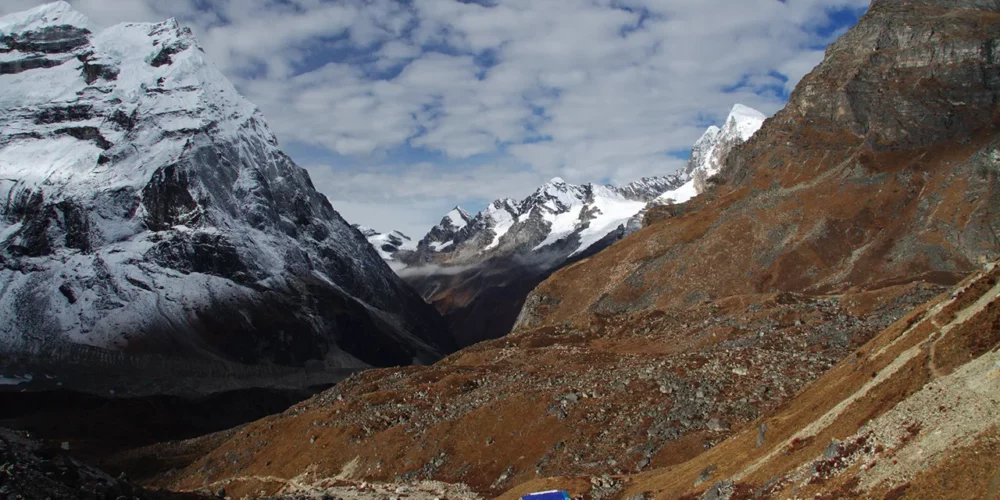
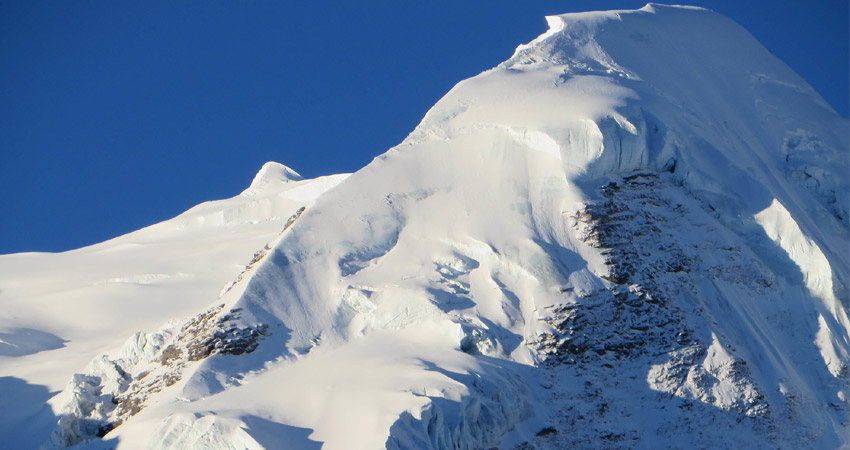




 Have Questions?
Have Questions?